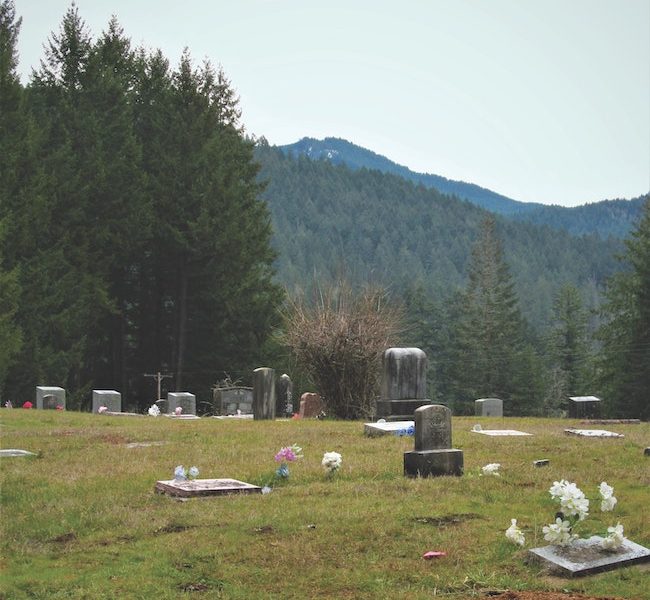 The room with a view.
The room with a view.
At the top of a knoll on Blue Mountain School Road that forces Mosby Creek to take a jog around it lies the Brumbaugh Cemetery. Like many of the area’s early pioneer burial grounds it sits on a high point with an inspiring view of the surrounding countryside.
The cemetery has served the local community starting in the early 1870s, and is sometimes called Blue Mountain or Mosby Creek Cemetery in old obituaries. The first plot of land for the burial ground was donated by the Brumbaughs, hence its name. Later an acre to the north was given by the Booth-Kelly Lumber Company, and to the south an acre was donated by Mr. & Mrs. R.G. Land, bringing the total plot to three acres.
The graveyard has changed over the years. According to Tom Jones, who by his own admission is related to just about everyone buried there and serves on the board of the Brumbaugh Cemetery Association, Blue Mountain Road went right through the cemetery. As a boy he had to help his grandfather mow the grounds, a task he didn’t particularly enjoy. “We actually hated it at times, taking the dried grass to Granddad’s barn.
Samuel Brumbaugh and his wife Lydia, according to family accounts, left St. Joseph, Mo., and crossed the prairies in 1866, settling first in French Prairie and then Howell Prairie near Salem. Moving westward was in the family’s blood. Samuel’s grandfather, Conrad, had immigrated from Germany (or Belgium) in 1765, settling in Lancaster, Pa. He served in the Cumberland County Militia during the Revolutionary War.
 Samuel and Lydia Brumbaugh.
Samuel and Lydia Brumbaugh.
Conrad was considered to be very well educated in Europe. In the Pennsylvania Dutch country he served as a teacher and as the first minister of the German Baptist Brethren in America. Both Samuel and Lydia’s obituaries mention their strong devotion to this branch. The GBB today is known as The Church of the Brethren.
By the time Samuel was born in 1818 his family was in Ohio. There he wed Lydia Ann Leer, in 1848. Samuel and Lydia made stops in Indiana, Illinois, and Iowa, children being born in the former and latter. Son Daniel Henry was 1 year old when the family took a buckboard and headed for Oregon. They didn’t come alone, two of Samuel’s older daughters had married Spong brothers and the extended family came along, altogether making up eight parties.
The family moved here from Salem in 1871 to a place near to what came to be called Brumbaugh River (now known as Mosby Creek). One handwritten family account cites a diphtheria outbreak as motivation for the move. While rare today, due to a vaccine and antibiotics, the disease was a deadly scourge in the 1800s and early 1900s. It affected mostly the young and the elderly, taking multiple, and in some cases, all of the children in a family. The mortality rate was about 25% for infected children. The records of the two Brumbaugh/Spong families show that out of their combined 12 children, eight of them died before age 6 including two sets of siblings that died within days of each other.
The requirement to make improvements to one’s homestead claim prompted the Brumbaughs to create the cemetery. Land records indicate that Samuel had an 83-acre homestead in 1885, but it took time to process a homestead claim into a land patent. Tom Jones remembers his grandmother describing a much larger parcel, around 1,000 acres. Times were hard in pioneer-era Oregon and some Brumbaughs sold out and headed back east.
The old cemetery sign has the date 1871 and tradition has it that the first burial in the cemetery was a young girl named Janie Lee. There is no known birth date for her and the cemetery records list her death as being between 1871-76, so that cannot be known for sure, but other Lee family members surround her gravesite. Her burial place is marked by a concrete pedestal that may have at one time supported a tombstone; a plastic name plate and a butterfly sculpture have been added more recently. Older accounts describe her resting place as being marked by “a sinking post.”
The Brumbaughs, along with several of their children and grandchildren, lay nearby. They are connected by marriage to the Spong, Lee, and Jones families, and these descendents take up a fair amount of real estate in what is known as the upper plot – which is reserved for original settler families.
In Opal Whiteley’s diary she describes visiting the “girl that has no seeing.” The young woman was practically blind from a childhood illness. Opal, knowing that she was lonely and that “she has seeing by feels,” would take her animal pets for visits and interesting nature objects for her to touch. She would also lead her out for walks in the fields and woods, and let her listen to the voices of the trees (wind in the leaves). To help her get the full experience, Opal once took out the hair pins and let the girl’s hair be blown by the breeze and also led her to the edge of the forest where sun and shadows met, allowing the darkness to touch the girl’s cheek.
 Girl that has no seeing.
Girl that has no seeing.
According to her diary, one day when Opal went for a promised visit there was no answer to her taps on the window pane. So she sat on the gatepost to wait for her friend. A passing man asked why she was sitting there. When she told him, he swallowed hard and looked off into the hills. “Child, she won’t come back. She has gone to the graveyard.” Opal interpreted this to mean she was visiting there and came back another day. Listening to other passersby she learned the sorrowful truth.
The Roseburg Plaindealer, April 17, 1905, tells the tragic end of Parthena Dowens. Miss Dowens was alone at home with her younger brother when he rushed into the house to tell her that a grass fire was approaching. “The young woman attempted to check the blaze but her clothing caught fire and in an instant they were a mass of flames.” She panicked and ran to try and find the water trough, which she eventually did, “but not before she inhaled them (the flames) and her body was fearfully burned.”
Dr. Job was summoned from Cottage Grove, but found his patient “beyond human help.” After an agonizing 12 hours, death released her from her suffering and she was buried in the Brumbaugh Cemetery. Without a doubt her vision impairment contributed to this accident.
The long dresses that were the style of the day commonly claimed lives around fires, including one of my great aunts in the Florida pioneer days. The girl that has no seeing, received some heartfelt and flowerful tributes submitted to the Bohemia Nugget. The Blue Mountain Christian Endeavor resolved to wear a badge of mourning for 40 days and sent verses to her family, a snippet of one that was published as follows: “Thena thou was’t mild and lovely, Gentle as the summer breeze, Pleasant as the air of evening, When it floats among the trees. Peaceful be thy silent slumber Peaceful in thy grave so low; Thou no more will join our number, There no more our songs shall know…”
Poor Thena was not the only one who left too soon. As is common in older cemeteries, there were a number of children’s graves. One plot had two markers from the 1800s noting two sons who died days apart.
There were older military headstones, most likely representing civil war veterans. A WWI stone commemorates “Thomas Patten, US Army Horseshoer.” This memorial remembers not only a doughboy, but the changing nature of war. “For the want of a nail the shoe was lost, for the want of the shoe the horse was lost, for the want of … The battle was lost.”
For longtime Grovers, the Brumbaugh Cemetery holds many names that are familiar: Rawlings, Duerst, Patten, Dowens, Hubbard, Lee, Jones, and Layng.
Layng Road and Creek take their name from George Layng, a plucky Irishman who left County Mayo in 1880, headed to a new life in the States. Having made his way to Oregon, Layng had a mule team and was working on the railroad when he saw some property up the Row River that he fancied. He sold his mules and bought cattle in Corvallis and drove them all the way up to Rujada where he settled. In 1897 he married Carrie Dowens (Parthena’s sister) and together they got into the meat packing business, butchering their cattle and taking a wagon up to the Bohemia Mines, carrying two beves at a time, in quarters. They would leave at 2 a.m. and it was a rough 20 miles up to the mines, taking all day. After spending the night in Bohemia City, they would deliver their meat to the outlying mines by pack horse. It was a tough way to make a living and in 1906 a legal notice appeared in the Eugene paper reporting the transfer of the Layng’s 180 acres to David Mosby for $1 (probably a land swap). Leaving his name with the Creek at Rujada, the Layngs headed downstream to where the road is named for them to live out their days. They got to celebrate their golden wedding anniversary before George passed at 97.
While some local pioneer cemeteries are open to anyone, the Brumbaugh is not. The Board of the Brumbaugh Cemetery Association, made up of descendents, decides who should be buried in the cemetery. There are two criteria: connected by family or by living in the Mosby Creek area. The lower section is for folks who live in the area but are more recent arrivals. As Jones notes “There is not enough room for everybody to be buried there so we want to keep it for folks connected to the area.”
On my visit I noticed that along the western fence line there is a row of graves that seem apart and in no way connected to the main part of the cemetery. There is also no apparent rhyme nor reason to its organization. Jones explained that the row started as reserved for babies but gradually more family members chose to be buried there as well and even though there doesn’t seem so, many are related and just have different surnames. He also explained there are also unmarked graves whose locations or names are forgotten and that they had had the problem of hitting old graves while digging new ones, prompting a closer look at existing records and maps. Time has a way of clouding the memories.
In any case the Brumbaugh Cemetery is a lovely, peaceful spot. It is also reassuring to know that there are Brumbaugh descendents living in Cottage Grove today, along with scions of many of the early families that also rest there. If we don’t understand and honor our past, we are most likely not to know where we are heading in the future.
Email: [email protected]








